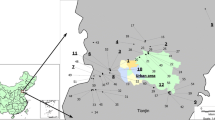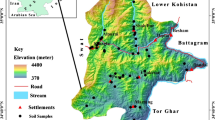Abstract
This study reports soil PAHs from a small city (Tezpur) of the mid-Brahmaputra Valley. The soil PAHs has been assessed from representative land use using detailed protocol of extracting, cleaning, and quantitative analysis by HPLC technique. The concentrations of PAHs showed minimum spatial variability and yet showed strong seasonal variability, which could be typical of small cities having weak local source strengths. On examining the air mass reaching the region, it appeared that there has been explicit effect of long-range transport. The HYSPLIT back trajectories reaching the study area during different seasons showed variations in terms of their origins and transport pathways. This might have led to differential long-range transport of PAHs, which is reflected in the seasonal variabilities of the concentrations of PAHs. The seasonal variations were much profound with the highest ΣPAHs concentration during post-monsoon (7961 ng g−1) followed by pre-monsoon (2414 ng g−1) and monsoon (773 ng g−1) season. The toxicity of the PAHs was examined as BaP equivalent (BaPeq) concentrations, which were found to be on the lower side as compared to the studies conducted elsewhere. The percentage contribution of 3- and 4-ring compounds was found to be greater. An attempt also was made to apportion the sources of the PAHs by application of diagnostic ratios, principal component analysis–multiple linear regression (PCA-MLR) and hierarchal cluster analysis (HCA), which revealed that coal and biomass burning and vehicular emissions are the major contributors to the PAHs load in Tezpur city.






Similar content being viewed by others
References
Agarwal, T. (2009). Concentration level, pattern and toxic potential of PAHs in traffic soil of Delhi, India. Journal of Hazardous Materials, 171, 894–900.
Agarwal, T., & Bucheli, T. D. (2011). Is black carbon a better predictor of polycyclic aromatic hydrocarbon distribution in soils than total organic carbon? Environmental Pollution, 159, 64–70.
Bhuyan, P., Barman, N., Bora, J., Daimari, R., Deka, P., & Hoque, R. R. (2016). Attributes of aerosol bound water soluble ions and carbon, and their relationships with AOD over the Brahmaputra Valley. Atmospheric Environment, 142, 194–209.
Bhuyan, P., Deka, P., Prakash, A., Balachandran, S., & Hoque, R. R. (2018). Chemical characterization and source apportionment of aerosol over mid Brahmaputra Valley, India. Environmental Pollution, 234, 997–1010.
Census of India. (2011). http://censusindia.gov.in/2011-Common/CensusData2011.html.
Dai, J., Li, S., Zhang, Y., Wang, R., & Yu, Y. (2008). Distributions, sources and risk assessment of polycyclic aromatic hydrocarbons (PAHs) in topsoil at Ji’nan city, China. Environmental Monitoring and Assessment, 147, 317–326.
Deka, J., Sarma, K. P., & Hoque, R. R. (2016). Source contributions of PAHs in soils around oilfield in the Brahmaputra Valley. Ecotoxicology and Environmental Safety, 133, 281–289.
Dong, T. T. T., & Lee, B. K. (2009). Characteristics, toxicity, and source apportionment of polycyclic aromatic hydrocarbons (PAHs) in road dust of Ulsan, Korea. Chemosphere, 74, 1245–1253.
Fakhradini, S. S., Moore, F., Keshavarzi, B., & Lahijanzadeh, A. (2019). Polycyclic aromatic hydrocarbons (PAHs) in water and sediment of Hoor Al-Azim wetland, Iran: a focus on source apportionment, environmental risk assessment, and sediment-water partitioning. Environmental Monitoring and Assessment, 191(4), 233.
Gope, M., Masto, R. E., George, J., & Balachandran, S. (2018). Exposure and cancer risk assessment of polycyclic aromatic hydrocarbons (PAHs) in the street dust of Asansol city, India. Sustainable Cities and Society, 38, 616–626.
Havelcova, M., Melegy, A., & Rapant, S. (2014). Geochemical distribution of polycyclic aromatic hydrocarbons in soils and sediments of El-Tabbin, Egypt. Chemosphere, 95, 63–74.
Hussain, K., & Hoque, R. R. (2015). Seasonal attributes of urban soil PAHs of the Brahmaputra Valley. Chemosphere, 119, 794–802.
Hussain, K., Rajbangshi, R., & Hoque, R. R. (2014). Understanding levels and sources of PAHs in water of Bharalu tributary of the Brahmaputra River. Asian Journal of Water, Environment and Pollution, 11, 89–98.
Hussain, K., Balachandran, S., & Hoque, R. R. (2015a). Sources of polycyclic aromatic hydrocarbons in sediments of the Bharalu River, a tributary of the River Brahmaputra in Guwahati, India. Ecotoxicology and Environmental Safety, 122, 61–67.
Hussain, K., Rahman, M., Prakash, A., & Hoque, R. R. (2015b). Street dust PAHs of a major city in the Brahmaputra Valley of South Asia: profile, toxicity, sources and seasonality of correlations with carbon. Sustainable Cities and Society, 19, 17–25.
Jiang, Y. F., Wang, X. T., Wang, F., Jia, Y., Wu, M. H., Sheng, G. Y., & Fu, J. M. (2009). Levels, composition profile and sources of polycyclic aromatic hydrocarbons in urban soil of Shanghai China. Chemosphere, 75, 1112–1118.
Kannan, K., Johnson, B.-R., Yohn, S. S., Giesy, J. P., & Long, D. T. (2005). Spatial and temporal distribution of polycyclic aromatic hydrocarbons in sediments from inland lakes in Michigan. Ecotoxicology and Environmental Safety, 39, 4700–4706.
Larsen, R. K., & Baker, J. E. (2003). Source apportionment of polycyclic aroma hydrocarbons in the urban atmosphere: a comparison of three method. Environmental Science & Technology, 37, 1873–1881.
Liang, J., Ma, G., Fang, H., Chen, L., & Christie, P. (2011). Polycyclic aromatic hydrocarbon concentration representing different land use categories in Shanghai. Environmental Earth Science, 62, 33–42.
Liang, J., Wu, H. B., & Wang, X. X. (2019). Distribution characteristics and health risk assessment of heavy metals and PAHs in the soils of green spaces in Shanghai, China. Environmental Monitoring and Assessment, 191(6), 345.
Maliszewska-Kordybach, B., Smreczak, B., Klimkowicz, A., & Terelak, H. (2008). Monitoring of the total content of polycyclic aromatic hydrocarbons (PAHs) in arable soils in Poland. Chemosphere, 73, 1284–1291.
Masih, A., & Taneja, A. (2006). Polycyclic aromatic hydrocarbons (PAHs) concentrations and related carcinogenic potencies in soil at a semi-arid region of India. Chemosphere, 65, 449–456.
Menzie, C. A., Potocki, B. B., & Santodonato, J. (1992). Exposure to carcinogenic PAHs in environment. Environmental Science & Technology, 26, 1278–1284.
Mizwar, A., Priatmadi, B. J., Abdi, C., & Trihadiningrum, Y. (2016). Assessment of polycyclic aromatic hydrocarbons (PAHs) contamination in surface soil of coal stockpile sites in South Kalimantan, Indonesia. Environmental Monitoring and Assessment, 188(3), 1–9.
Mohammed, S., Obiri, S., Ansa-Asare, O. D., Dartey, G., Kuddy, R., & Appiah, S. (2019). Assessment of concentration of polycyclic aromatic hydrocarbons (PAHs) in vegetables from farms in Accra, Ghana. Environmental Monitoring and Assessment, 191(7), 417.
Park, S. S., Kim, Y. J., & Kang, C. H. (2002). Atmospheric polycyclic aromatic hydrocarbons in Seoul, Korea. Atmospheric Environment, 36, 2917–2924.
Ray, S., Khillare, P. S., Agarwal, T., & Shridhar, V. (2008). Assessment of PAHs in soil around the International Airport in Delhi, India. Journal of Hazardous Materials, 156, 9–16.
Rolph, G., Stein, A., & Stunder, B. (2017). Real-time environmental applications and display system: READY. Environmental Modelling and Software, 95, 210–228.
Shi, B., Wu, Q., Ouyang, H., Liu, X., Zhang, J., & Zuo, W. (2015). Distribution and source apportionment of polycyclic aromatic hydrocarbons in the surface soil of Baise, China. Environmental Monitoring and Assessment, 187, 1–14.
Simcik, M. F., Eisenreich, S. J., & Lioy, P. J. (1999). Source apportionment and source/sink relationships of PAHs in the coastal atmosphere of Chicago and Lake Michigan. Atmospheric Environment, 33, 5071–5079.
Singh, D. P. (2012). Levels, sources, and toxic potential of polycyclic aromatic hydrocarbons in urban soil of Delhi, India. Human and Ecological Risk Assessment: An International Journal, 18, 393–411.
Škrbić, B., Cvejanov, J., & Durišić-Mladenović, N. (2005). Polycyclic aromatic hydrocarbons in surface soils of Novi Sad and bank sediment of the Danube River. Journal of Environmental Science and Health, 40(1), 29–42.
Stein, A. F., Draxler, R. R., Rolph, G. D., Stunder, B. J. B., Cohen, M. D., & Ngan, F. (2015). NOAA’s HYSPLIT atmospheric transport and dispersion modeling system. Bull. Amer. Meteor. Soc., 96, 2059–2077.
Suman, S., Sinha, A., & Tarafdar, A. (2016). Polycyclic aromatic hydrocarbons (PAHs) concentration levels, pattern, source identification and soil toxicity assessment in urban traffic soil of Dhanbad, India. Science of the Total Environment, 545, 353–360.
Tang, L., Tang, X. Y., Zhu, Y. G., Zheng, M. H., & Miao, Q. L. (2005). Contamination of polycyclic aromatic hydrocarbons (PAHs) in urban soils in Beijing, China. Environment International, 31, 822–828.
Tobiszewski, M., & Namieśnik, J. (2012). PAH diagnostic ratios for the identification of pollution emission sources. Environmental Pollution, 162, 110–119.
Tsai, P. J., Shih, T. S., Chen, H. L., Lee, W. J., Lai, C. H., & Liou, S. H. (2004). Assessing and predicting the exposures of polycyclic aromatic hydrocarbons (PAHs) and their carcinogenic potencies from vehicle engine exhausts to highway toll station workers. Atmospheric Environment, 38, 333–343.
UNEP (1992). Reference method for marine pollution studies no. 20 (IOC, IAEA), United Nations Environmental Program.
USEPA (1977). Sampling and analysis procedures for screening of industrial effluents for priority pollutants. U. S. Environmental Protection Agency. Environment Monitoring and Support Laboratory, Cincinnati.
USEPA (2002). Polycyclic organic matter, US Environmental Protection Agency.
Von Lau, E., Gan, S., & Ng, H. K. (2012). Distribution and source apportionment of polycyclic aromatic hydrocarbons (PAHs) in surface soils from five different locations in Klang Valley, Malaysia. Bulletin of Environmental Contamination and Toxicology, 88(5), 741–746.
Wild, S. R., & Jones, K. C. (1995). Polynuclear aromatic hydrocarbons in the United Kingdom environment: a preliminary source inventory and budget. Environmental Pollution, 88, 91–108.
Yamasaki, H., Kuwata, K., & Miyamoto, H. (1982). Effects of ambient temperature on aspects of airborne polycyclic aromatic hydrocarbons. Environmental Science & Technology, 1982(16), 189–194.
Yuan, H., Li, T., Ding, X., Zhao, G., & Ye, S. (2014). Distribution, sources and potential toxicological significance of polycyclic aromatic hydrocarbons (PAHs) in surface soils of the Yellow River Delta, China. Marine Pollution Bulletin, 83, 258–264.
Yunker, M. B., Snowdon, L. R., Macdonald, R. W., Smith, J. N., Fowler, M. G., Skibo, D. N., McLaughlin, F. A., Danyushevskaya, A. I., Petrova, V. I., & Ivanov, G. I. (1996). Polycyclic aromatic hydrocarbons composition and potential sources for sediment samples from the Beaufort and Barents Sea. Environmental Science & Technology, 30, 1310–1320.
Yunker, M. B., MacDonald, R. W., Vingarzanc, R., Mitchell, R. H., Goyette, D., & Sylvestre, S. (2002). PAHs in the Fraser River basin: a critical appraisal of PAH ratios as indicators of PAH source and composition. Organic Geochemistry, 33, 489–515.
Zhang, R., Zhang, F., & Zhang, T. C. (2013). Sedimentary records of PAHs in a sediment core from tidal flat of Haizhou Bay, China. Science of the Total Environment, 450-451, 280–288.
Acknowledgments
Authors thank ONGC-CPBT, Tezpur University to Professor K.P. Sarma and Professor R.R. Hoque and the UGC, Government of India for providing with RGN Fellowship to Dr. Jinu Deka.
Author information
Authors and Affiliations
Corresponding authors
Additional information
Publisher’s note
Springer Nature remains neutral with regard to jurisdictional claims in published maps and institutional affiliations.
Electronic supplementary material
ESM 1
(DOCX 16 kb)
Appendix
Appendix
Rights and permissions
About this article
Cite this article
Deka, J., Baul, N., Bharali, P. et al. Soil PAHs against varied land use of a small city (Tezpur) of middle Brahmaputra Valley: seasonality, sources, and long-range transport. Environ Monit Assess 192, 357 (2020). https://doi.org/10.1007/s10661-020-08296-0
Received:
Accepted:
Published:
DOI: https://doi.org/10.1007/s10661-020-08296-0




